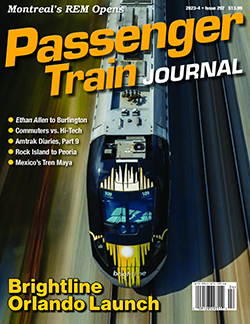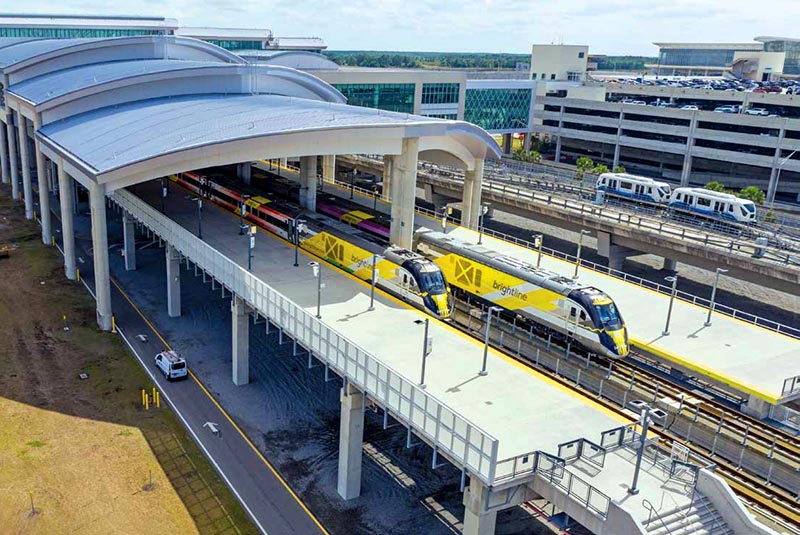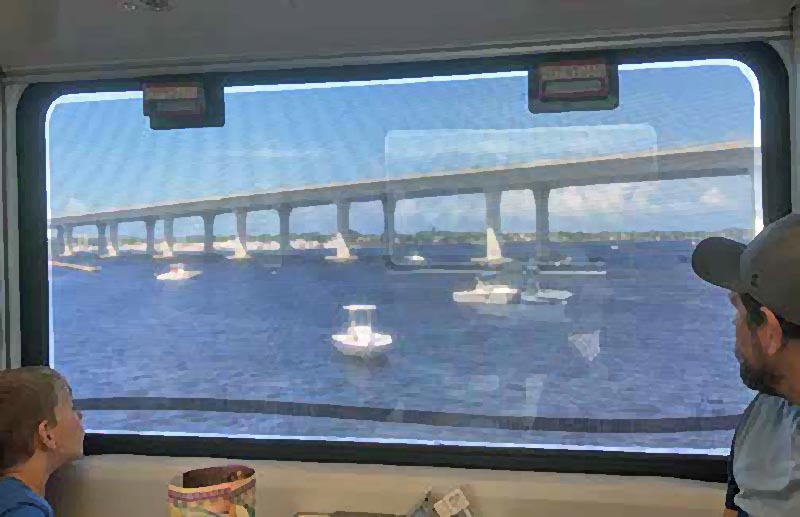 by Jack M. Tuner/photos as noted
by Jack M. Tuner/photos as noted
September 22, 2023, was a red-letter day for railroading in Florida with the grand opening of Brightline higher-speed train service between Orlando and Miami. Passenger Train Journal was on hand to ride the second revenue southbound train as part of a round-trip between Orlando and Miami.
Brightline operates out of Orlando International Airport (MCO) and travels across newly constructed tracks for 35 miles to a point north of Cocoa, where it joins Florida East Coast Railway’s main line from Jacksonville. Brightline trains then traverse FEC for approximately 196 miles, all the way to Miami.
Brightline commenced service between Fort Lauderdale and West Palm Beach in January 2018 and extended the southern terminal to Miami in May 2018 while the new Orlando line was under development. There had never been any type of freight or passenger rail service eastward from Orlando, thus Brightline literally was breaking new ground.
The Florida East Coast story
Florida East Coast (FEC) traces its history back to the 1880s, when former Standard Oil executive Henry Flagler visited St. Augustine and noted a lack of lodging in the city as well as an absence of railway connections to the north. Flagler began construction of the stately Ponce de Leon Hotel in downtown St. Augustine in 1885, and soon acquired the Jacksonville, St. Augustine & Halifax Railroad linking Jacksonville and St. Augustine. After converting that narrow-gauge railroad to standard gauge, he purchased three more railroad companies, extended service to Daytona Beach, and revitalized a hotel nearby. Beginning in 1892, Flagler began laying tracks southward and new communities sprang up along the Flagler System route.

ABOVE: This aerial view of Brightline’s Orlando station takes in the elevated platforms, an Intermodal Terminal line automated people-mover train, the large parking structure, and Orlando International Airport’s Terminal C. —Courtesy Brightline
In 1895, this undertaking was incorporated as the Florida East Coast Railway, and a year later the rails reached Biscayne Bay and the village of Fort Dallas. Local residents wanted to rename the community in honor of Flagler but he declined, preferring to name it Miama, the Native American name for the river running through what came to be called Miami. After seven years of construction, the FEC line was extended via numerous bridges between the islands of the Florida Keys, with this Key West Extension completed in 1912. Naysayers nicknamed the line “Flagler’s Folly;” however, the “Overseas Railroad” successfully transported freight bound for Latin America and countries accessed via the new Panama Canal, as well as passengers headed to the southernmost point in the continental United States and on to Cuba via steamship. The 1935 Labor Day hurricane heavily damaged the Overseas Railroad and ended rail service to Key West. Though Henry Flagler had passed away years earlier, his legacy lived on through the growth of the east coast of Florida, fueled by the arrival of FEC.
Passenger service over FEC was popular with northern tourists flocking to sunny South Florida via Atlantic Coast Line trains from New York and Chicago, which were forwarded to Miami over Florida East Coast’s rails. A total of eight trains from northern points served the FEC line in 1951. In the 1960s, New York City trains included the East Coast Champion and winter-season Florida Special. Chicago trains included the City of Miami — run in conjunction with Illinois Central, Central of Georgia, and ACL — and the South Wind, forwarded by Pennsylvania Railroad, Louisville & Nashville, and ACL.

ABOVE: The temporary advertising wrap on the Bright Pink trainset left passengers with a reduced view. Watching the scenery from across the aisle improved the clarity. —Jack M. Turner
A contentious labor strike shut down FEC in January 1963. Correctly sensing that the disruption would not conclude anytime soon, ACL trains bound for Miami were rerouted over ACL tracks to Auburndale, Fla., then down rival Seaboard Air Line’s main line through the interior of the state to West Palm Beach and Miami. ACL and SAL merged to become Seaboard Coast Line in July 1967, and passenger trains have remained on that route (now CSX) under Amtrak.
The strike did not completely end passenger service on Florida East Coast, as in 1965 a federal court ordered FEC to operate a Monday-through-Saturday passenger train between Jacksonville and North Miami (the Miami station had been torn down during the early years of the strike.) This “strike train” consisted of a locomotive, one coach, and an observation car sold as parlor-car seating. Regulatory permission was granted to end this service in 1968. As the years rolled by, rumors of restored passenger service came and went; however, nothing came of this for more than 50 years. FEC did not look favorably at proposals to allow Amtrak to operate on its tracks, and it appeared unlikely that passenger trains would ever shine FEC rails again…



